Newton “Tom” Sigel has come a long way since the early days of his career as a Director of Photography on the television hit “The Wonder Years”. Honing his craft on films like “The Usual Suspects”, “Brokedown Palace” and “Three Kings”, it wasn’t long before Sigel found himself lighting and lensing on bigger budget projects from “Valkyrie” to “Superman Returns” while delivering nuanced visual metaphor in indie films like “Towelhead”. Sigel’s career jumped into overdrive with “Drive” followed quickly by “X-Men: Days of Future Past”, “X-Men: Apocalypse” and more. And now with BOHEMIAN RHAPSODY, Tom Sigel tackles perhaps the biggest challenge (and biggest playground) of his career as a cinematographer. The result is outstanding both visually and with visual storytelling. It’s one thing to design, light and lens beautiful visuals and create a cohesive tonal bandwidth. It’s next level when the visual design and texture tells its own layer of storytelling. That’s what Tom Sigel does here.
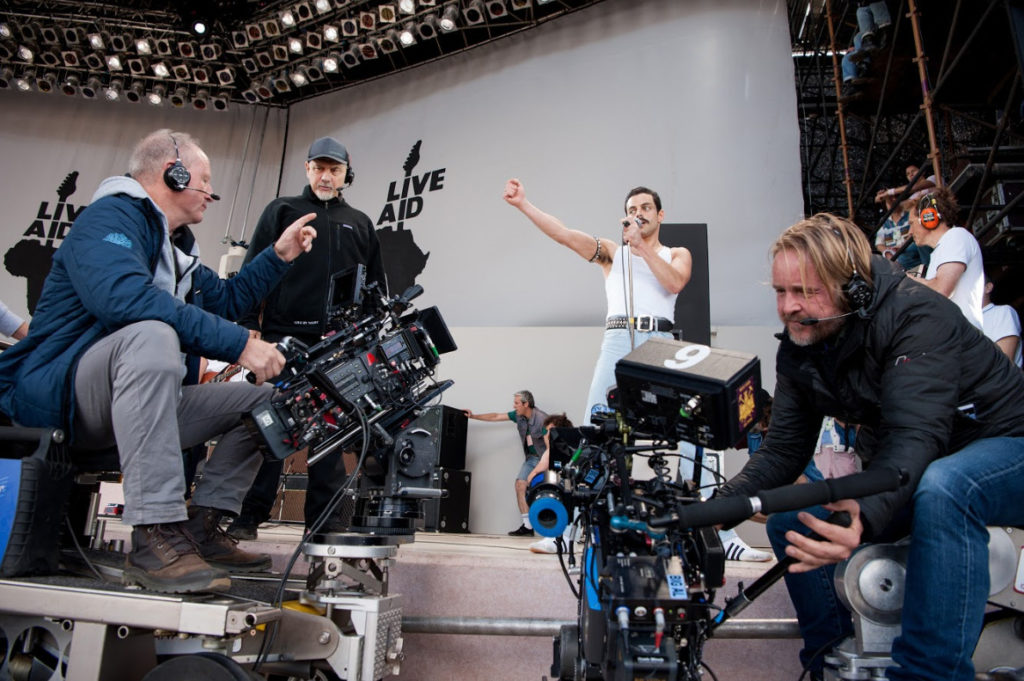
One of the most impressive aspects of BOHEMIAN RHAPSODY is Tom Sigel’s cinematography and the film’s visual tonal bandwidth which not only echoes the meteoric rise of Queen but the genius and internal conflict and ambiguity of Freddie Mercury. Reflecting the aesthetic changes of pop culture from the early days 70’s through the glam rock years and into the 80’s and culminating with Live Aid on July 13, 1985, lighting and lensing dazzles, most notably with the concert set pieces.
Contrasting the electrifying and cutting-edge stylization of the concert lighting is the vibrancy of the clubs frequented by Freddie in the 80’s awash with the rich red lighting and pops of color underneath the red. While ambient, it also metaphorically yells out “stop”. Lighting and lensing Freddie’s mansion is almost magical, yet there is an intimacy in his piano room with the Tiffany lamp by the window as he clicks it on and off signaling Mary, like a little boy with a tin can and thread would do with his BFF next door. The warmth of Freddie’s parents home is welcoming, inviting, cozy, but given what Malek brings to Freddie through performance, we can feel the claustrophobic nature of the home from his perspective. A delicate visual balancing act that works in tandem with Malek’s performance. Notable are significant moments where the lighting matches the musical beats, creating a visual lyricism which editor John Ottman further implements with his cuts, dissolves, creating an almost hypnotic emotional experience.
A playground for a cinematographer like Sigel, BOHEMIAN RHAPSODY gave him a chance to spread his already wide-spanned wings and match the creativity of Queen’s own stage production values with his own and he more than meets the challenge. While embracing Queen’s own innovative concert production values which set the concert standard back in the day, Sigel takes them to new heights here, making full use of stages and camera movement, enhanced by shooting with the Arri Alexa 65 and using the Hasselblad Prime DNA and Prime 65-S lenses. And don’t look for a shot for shot Live Aid set-up. While the stage is identical, the performance the same, Sigel takes the camera behind the scenes giving us a peek into what was happening before Queen rocked the world at Wembley. The camera lets the audience be part of that magic.
On location in India in pre-production on his latest film “Dhaka” (which Sigel admittedly describes as “not my typical cup of tea”), directed by Sam Hargrave, produced by the Russo Brothers and starring Chris Hemsworth, Sigel took time out to speak with me by phone in this exclusive interview talking BOHEMIAN RHAPSODY. . .

One of the big things with Bohemian Rhapsody is the cinematography. I’d love to hear how you worked with Bryan [Singer] and how you developed your visual tonal bandwidth because your visuals very distinctly follow the emotional beats of Freddie’s life and the meteoric rise of Queen. You had to be like a kid in a candy store with this one given you got to do concert lighting, stage lighting, the whole Live Aid Wembley recreation. Then you’ve got intimate clubs, the family home, which has a distinct golden warmth to it, plus, taking into consideration the 15-year time span and culture changes affecting the different period looks. When you first learned you were making this film and first sat down with Bryan, how did you figure out what your look was actually going to be?
Well, it was interesting because I knew Queen’s music and I liked it and I always was sort of fascinated with how it had infiltrated popular culture and sports stadiums and sporting events, but I didn’t really know much about the band. And when I got Bohemian Rhapsody, when I got the script, and I started doing my research, I read every book there was about Freddie and about the band. I watched all the archival material, and the movie started appearing in my head. It started coming to me in terms of the look and also starting to sort of absorb the way that the band themselves changed and how it reflected popular culture changing, from sort of the tail end of kind of the counter-culture, dipping through the glam rock period of the late ’70s, and then you wound up with this kind of ’80s aesthetic that particularly Freddie was at, at the moment when Live Aid came around.
So it was a shift in the look of the band, very much so in terms of Freddie’s look as he became comfortable with his own sexuality, his own place, and what was happening in the culture as a whole, both in the UK and in the United States. So, the movie started appearing in my mind’s eye, and then it was just a question of what are the tools to capture this? Like, how am I going to express this with or get it on camera? Then we did some tests to see certain costumes and color combinations, lens, camera combinations, filtration, lighting, all that stuff, and it evolved. It evolved both in terms of the dramatic through-line of the movie, and it evolved in terms of the musical performance because it certainly went a long [way] from college clubs with a 100 people in the audience to Wembley Stadium with 130,000 and another billion people watching on TV.

I’m curious, Tom, because of the distinct looks – when the film opens after the Live Aid teaser and we meet Freddie and see his home and his family, it’s much softer, very romanticized and warm lighting versus what we see probably a little after mid-point in the film when everything is sharper and very crisp. You obviously got a shift in lenses that you’re using between those, and I love how it matches Freddie’s coming into his own skin when things get sharper and not as soft and is blurred, so to speak. What lenses did you use and what camera lens packaging did you go with to create these very distinct looks?
The first act of the movie is done on the Alexa SXT and the vintage Cooke Speed Panchro Lenses that are quite old. On top of that, we created a lot which was specifically designed for that period of his story. Then we utilized the Top of the Pops and around that period when they became known, they became known on sort of a bigger, national, and eventually [an] international stage, to shift to the Alexa 65 and the Arri DNA lenses. But what really helped the transition, so that it wasn’t like a flip of a switch, was that in Top of the Pops we also mixed in some Beta Cam material. Because Top of the Pops, which was a broadcast, we wanted to sort of replicate their tonality of what the broadcast at that time looked like. And so we found some old, buried Beta Cam cameras, and how we found the tape for it is a mystery to me, but we did. And so because of that you have this mixture of format as it’s transitioning. Again it happens with the “I Want to Break Free” video where we actually utilize 35 film and we shot it on the original camera from Freddie’s music video, which I found in storage. So you had these different formats helping the transition to where we had the Alexa 65, and the DNA lenses.

Now, this is obviously going to be shown in IMAX. Knowing that it’s in IMAX, does that present any kind of new considerations or challenges for you? I know you’ve worked with that before, but I’m curious, is that something that you have to factor into the decisions that you make?
The IMAX version is fabulous. . .First of all, on this particular film we didn’t know for sure that it was going to be on IMAX. We had no idea at the time that we were shooting. But the film, in particular for a movie like this, when I’m designing the look and choosing the technology and fine-tuning the lighting, it’s always done with the imagination of it being on the biggest screen you could possibly see it on. There are so many different formats people watch media on these days there’s no one size fits all, so I think when you shoot for the biggest screen possible and then you hope by extension that when you get smaller it only looks that much better. Obviously when you do the color corrections, nowadays it’s become very complicated because we have to do a Rec 709, we do an HDI, we do a Dolby Laser, we do an IMAX, we do an IMAX Laser, so there’s these multitudes of venues that you’re doing your DI and color correction for. And I think if you sort of aim for the highest bar you can always adapt all the other formats easier than if you’re analyzing stuff on a much lower format and then trying to figure out how to make it live on a huge screen.

I know whenever you’re dealing with color it affects lighting, and here because of the decades and the time periods we go through, color is so important not only to the emotional mood and tone of what’s happening with Freddie and with the band and the world, but also to the entire look because when we start in the early ’70s, as you had said earlier, coming out of the hippie era, the soft color palette, the muted tones, those wonderful kitchen avocado greens and yellows and golds that we all remember and is distinctly different than when we move into the glam rock, into disco, and all that color shifting, so how important is it for you working with your production designer, Aaron Haye, when it comes to color, and then you having to light and lens that?
Well, it’s critical because the production designer and the costume designer are really two parts of a triangle which I’m the third, and no matter how good your lighting or your cinematography, to a certain degree your starting point is always what they give you to put in front of the camera. So if you’re not working in concert with them, you already have a handicap to begin with. The color palette in Bohemian Rhapsody is an interesting one because I wanted to sort of homage and pay tribute to the design elements of the ’70s into the ’80s and change that happens in contemporary design during that 15 year period, but I also wanted to use color to reflect what was happening with the band, but Freddie in particular.
So it’s kind of like the foundation, and the foundation is what you build with the designer and the costume designer, was one that very much emulated the design elements that were prevalent in the ’70s and the early ’80s. And then the second layer is the one that is the emotional layer where, as you mentioned, there’s a more sort of golden romantic look; the idolized view, almost naïve view, that Freddie has and the band in the beginnings of their career, which comes into a sharper focus and a more complex, really, interaction with the world as they become international celebrities and superstars. So that color palette, which was a very sort of warm and golden one initially and then becomes a more saturated and cooler look as the story evolves, is sort of the emotional expressionism that’s being done through color that’s sort of laid on top of the foundation of the period. So it’s kind of like a two-layered approach to color throughout the film, and it really does tell the story.

Is it a help or a hindrance to you as a cinematographer, and especially in this case, because there is so much archival footage of live performances of the band, of course, Live Aid there’s the whole documentary series, more than a billion people saw that and you know the die-hard fans are going to be scrutinizing every single thing and bit of minutia with every concert moment that we have, so is it a help or a hindrance for you to have visual reference to call upon? And do you feel incumbent to replicate the exact stage lighting or something like that?
Well, I think it’s a huge help. Whether or not you choose to use it really depends on the story you’re telling, right? In other words, if you decide you want to do something that’s very almost documentary-like or historically accurate, it’s massive help. And if you decide that you just want to do something totally expressionistic and fantastical, maybe you don’t need to look at it all, or you look at it as you choose. So like everything on the web, it’s there for you to use if you want but it doesn’t mean you have to become tied to it. Having said that, for our particular story there’s poetic license and liberties taken just to get this epic band’s story into two hours. But we did, by and large, want to stay truthful to the real story.
In Live Aid, in particular, the stage was recreated meticulously. I mean, the entire concert lives on YouTube as the BBC broadcast it. So that was one where again, there was two elements, that one where we recreated it very specifically and very exactly, on the other hand, we didn’t want to just reproduce the camera angles because then you just go watch it on YouTube, [so] why are we making a movie? So really what our approach was to recreate the stage, for the most part the lighting, even though it was really pretty much Live Aid, and yet tell the story from the inside out. In other words, tell the story with the characters that we’ve been watching for the last hour and a half, and what was going on between them and see them. So we wanted to put the movie audience more up on the stage with the characters and seeing the interactions between characters that was based on what was … you know, I don’t want to give anything away, but what was happening right at that moment. You know, very heavy.
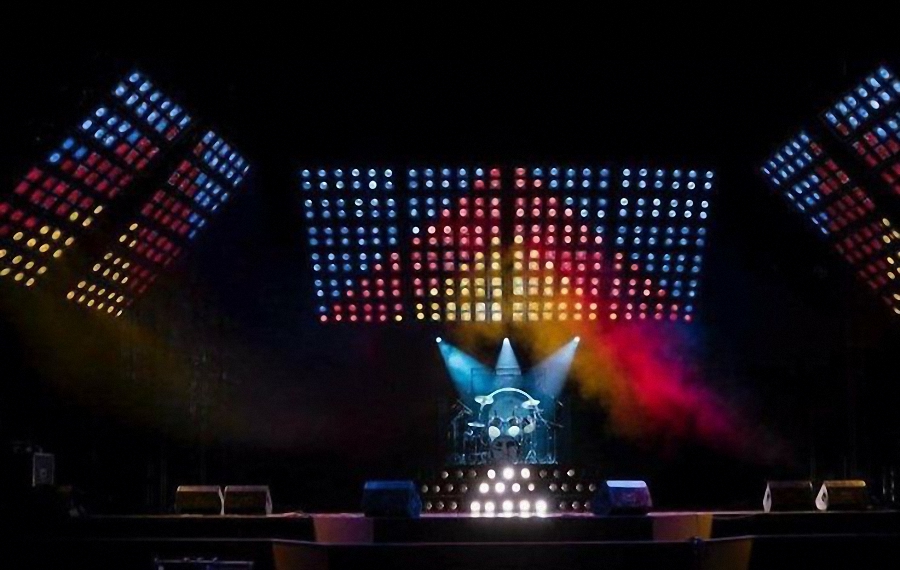
And what about with the live concert sets that are inserted throughout here? The whole montage of a lot of these concerts? Did you call upon just regular concert stage lighting that you implemented here, or did you specifically reference certain key elements that Queen would incorporate into their performances?
Yeah. No, I totally wanted to respect Queen’s lighting. You know, Queen was, in the ’70s in particular, actually ’70s and the ’80s, they were really at the very forefront of concert lighting. They had some of the biggest lighting rigs in the world at the time. They made use of the Vari-Lite which Genesis had promoted as a whole new leap forward in stage lighting. So I looked at all of their material and I tried to get an arc in the evolution of their stage lighting, where initially it was more just traditional par can, and then they introduced this great drum riser with aircraft landing lights, and then there was these massive racks of par cans that they would program color sequences into and they could lower and raise in the middle of concerts, and then they introduced the Vari-Lite. So I pretty much tried to build it like a layer cake where each concert got more and more elaborate until you get to Madison Square Garden when it’s just like full on massive lighting rigs.
It was difficult because we had very little time to shoot that stuff and sometimes I had to do two concerts in the same day, so we had this one lighting rig that was very modular and we would raise pieces of it and lower pieces of it into place. I had all of the sequences pre-programmed so we could just go, “Okay, now we just went from Edinburgh, now we’re going to Madison Square Garden.” That was a huge challenge. While it looked massive in the movie it was actually done fairly economically in a short period of time. So that was one of the biggest challenges of the whole movie.

Are you ready to go out as a roadie now with a band somewhere after this experience?
I think after seeing what they have to do to put on a concert I’ll leave that to them. (laughing)
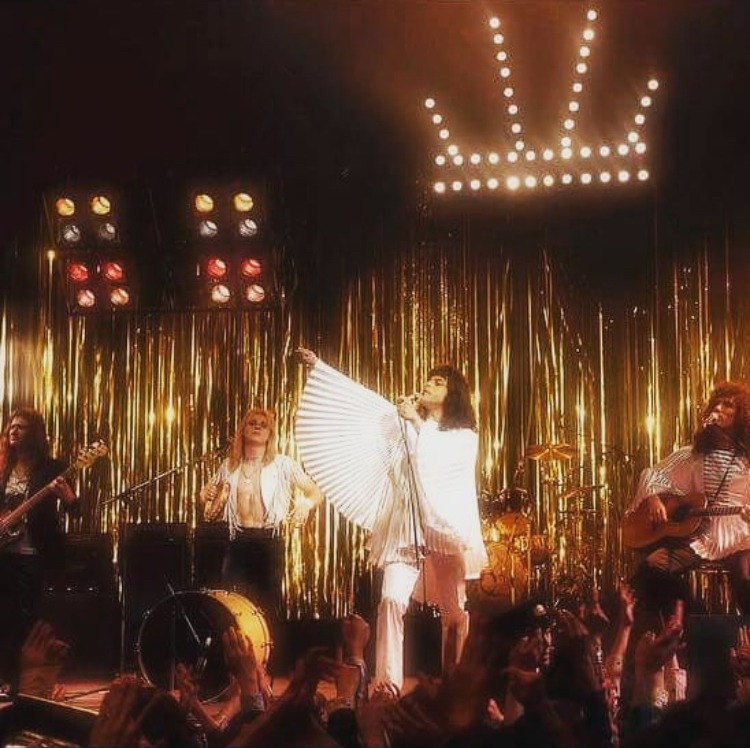
Because you did have so many locations here and very large, expansive ones down to intimate ones, as you sit back and you reflect on the making of the film, what did you find to be the most challenging aspect of your work, and at the same time the most gratifying?
I think that the most challenging one really was right at the top. You know, you have this band which is so iconic and a lead singer that’s even more iconic, and it’s, how do you find a language to tell their story that is honest and truthful to who they were and who they are? And that’s really kind of daunting. When you’re doing, like, A Star is Born, you’re starting from a fictional place, maybe you have a reference to the previous remake, but for us with Bohemian Rhapsody, you’re choosing a language to tell an incredibly famous person’s story. So discovering that and being comfortable with it, embracing it, feeling that you’ve found a truthful place to be, that was very daunting and honestly, it took me a good way into the movie before I felt comfortable that I had found it.

The whole thing, it is just so masterful, Tom. As I told FOX after I saw the film, “This is movies, music, and mastery all rolled into one.” And your work is a huge, huge part of that, Tom.
Thank you.
You’ve seen so many actors transform, put forth their performance over the years, what was the experience like watching Rami Malek become Freddie Mercury? Because for my money, this is one of the most immersive and transformative performances I have ever seen.
The very first time I really met him was he had a little make-up test, not even a real camera make-up test, more just trying some clothes on, trying some wigs on. And this was really early in the process. He came out of his room with the mustache and kind of pranced out in front of me, and I was like “Oh my God, it’s Freddie Mercury!” And he put Freddie Mercury on like an old pair of jeans. It was unbelievable. And he was like that consistently through the whole shoot. I’ve rarely seen anybody embody a character so profoundly, so deeply. It actually kind of reminds me of Val Kilmer in “The Doors” way back when I worked with Bob Richardson on that movie. But I thought that Rami was pure magic. I had no idea, no matter how much you look at material and practice in front of the mirror and get a movement coach or any of those things, he was just phenomenal. And he had a very good movement coach. Polly Bennett did a terrific job with him. Hair and make-up did a great job. Everybody did a great job helping him, but I’m telling you, he could have done Freddie Mercury without a costume, without a wig, and he would have nailed it 100%. He’s an absolutely phenomenal actor. And it makes it so much more fun to see it. I mean, when you have somebody who is so at the top of their game, it’s so exciting and you’re looking through the lens of the camera and you’re like “Oh my God.”
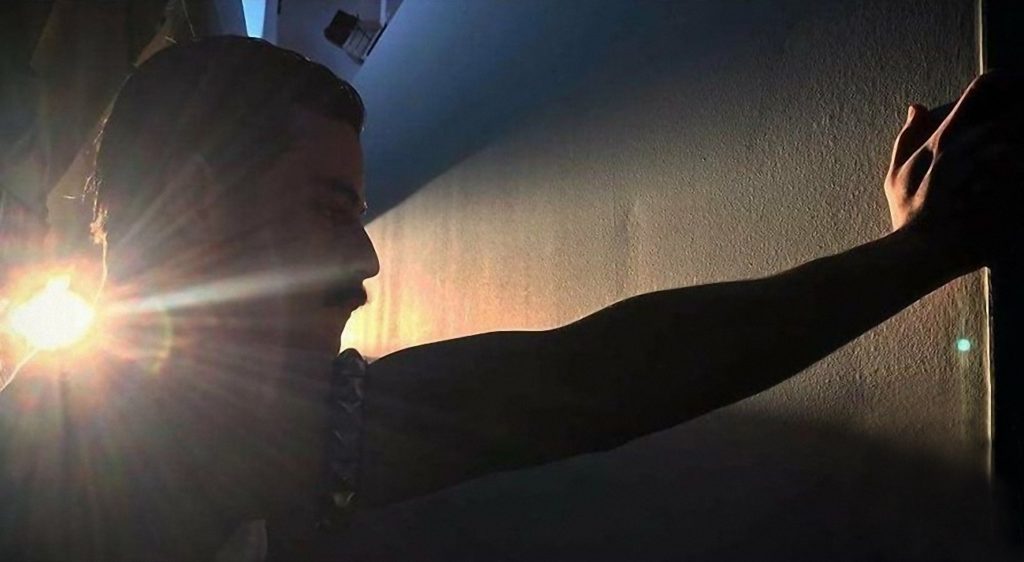
When you were watching him and the other guys perform, because looking at all of them, you look at Gwylim Lee, who I was doing double takes, it’s like “Oh my God, did they put Brian May in a time machine and just take him back?”, because you watch them play and you watch how they hold the instruments … and I have to imagine for you being there on set, are there moments like that with performances like these where you forget that you’re actually shooting a movie and it’s like you are transported?
I don’t know if you ever forget that you’re shooting a movie because you’re still panning and tilting and focusing and there’s lighting cues, but it’s totally transformative. I mean, there’s nothing like completing a really great take of something and coming off the set and going like, “Whoo, we got it! My God, that was amazing!” It’s a phenomenal feeling. And with these guys, every day was transformative. The whole band came together, we would go out at night sometimes and drink and laugh, and it was really a phenomenal group. Amazing.
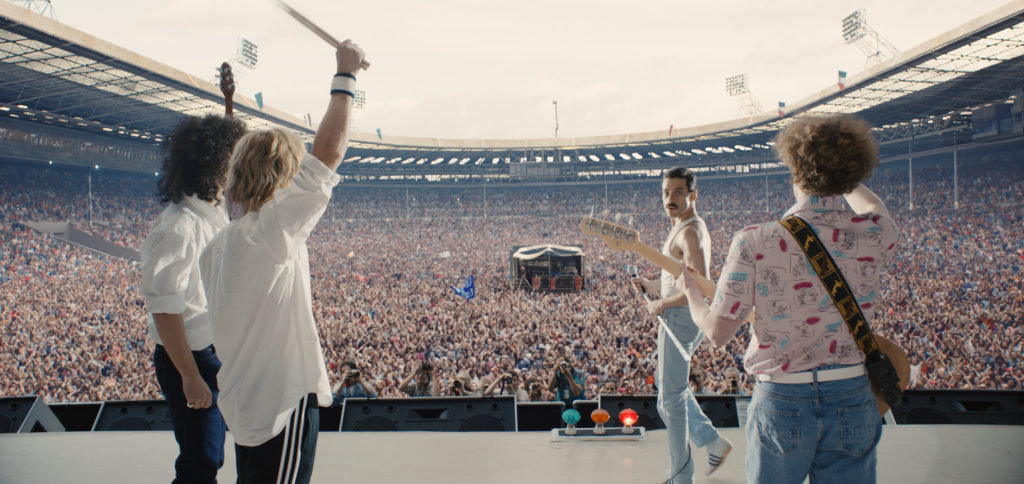
Tom, congratulations on your work here. I’ve been a huge admirer of your work for decades now and I see little things like “Towelhead” that you’ve done, and “Drive” which is flawless, I mean just so incredibly lensed, and even into something like “Valkyrie” or working with Clooney, and the superhero movies. But this? I’ve got to tell you, this is one of the finest you’ve ever done.
Thank you. It’s interesting, you know, because when I think of “Three Kings” or “Drive” or “Confessions of a Dangerous Mind”, films that I’m very proud of and that I see kind of imitated or I see how they’ve influenced films that were done right afterwards, and you get a certain feeling of joy to think that you’ve had that kind of influence among your peers, but this is the first time that anybody’s ever paid this much attention to me, so it’s kind of nice.
by debbie lynn elias, interview 10/18/2018











